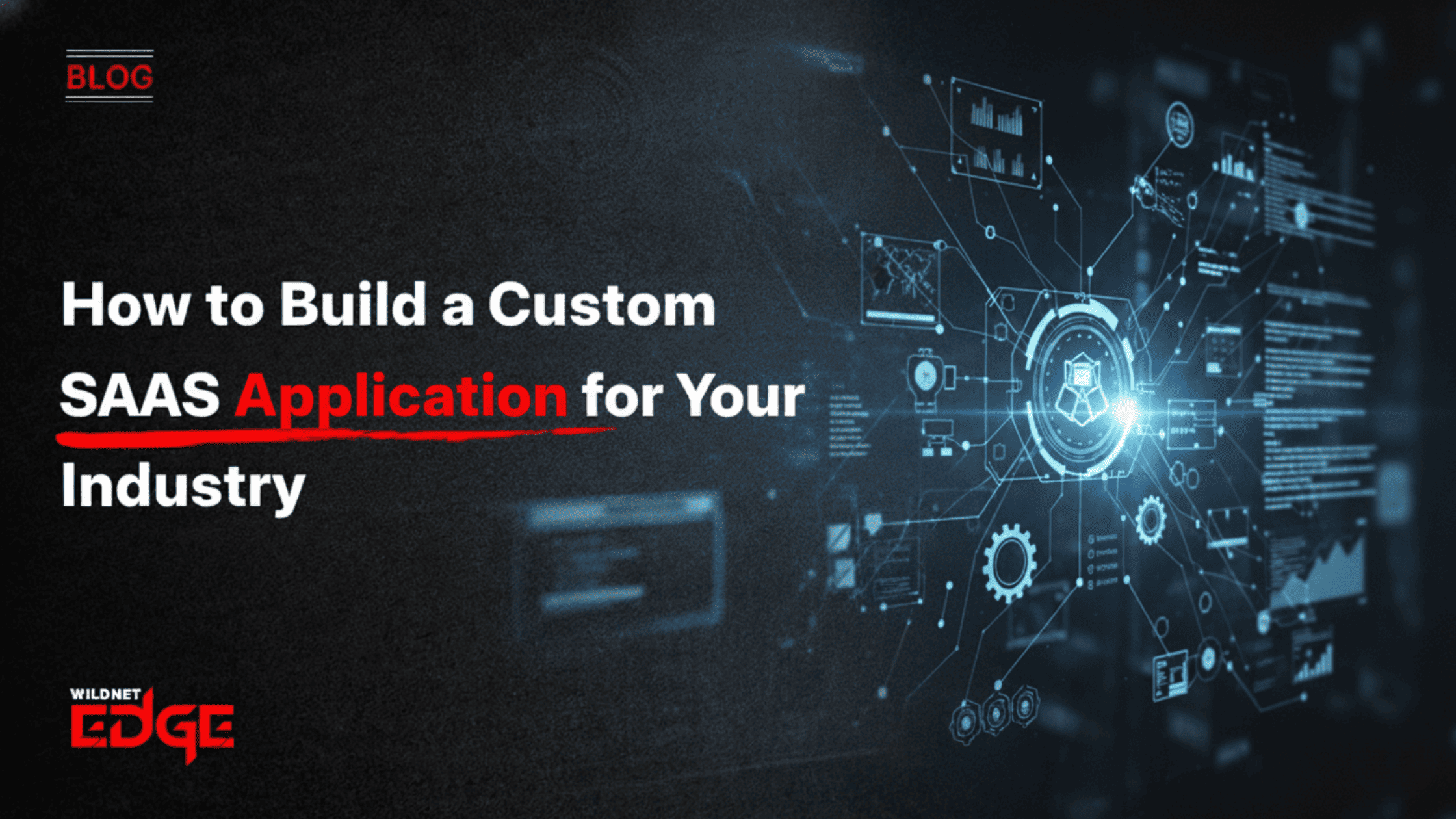TL;DR
This article explains how businesses can strategically build custom SaaS applications for their industry’s needs. Unlike generic tools, custom SaaS solutions align perfectly with unique workflows, offering better scalability, integration, and security. It outlines the process from market validation and MVP design to agile development and launch, showing how a tailored SaaS platform can drive efficiency, growth, and long-term market advantage.
The Software-as-a-Service market is booming, offering businesses a vast array of tools for nearly every conceivable function. Platforms like Salesforce for CRM or Hubspot for marketing provide robust, ready-made solutions. However, these generic platforms often fall short for businesses with highly specialized workflows, unique compliance requirements, or a desire to build a distinct competitive advantage. The solution? Building your own custom SaaS application, a platform designed precisely for your needs and potentially your entire industry.
What is a Custom SaaS Application?
A custom SaaS application is nothing but a cloud-based software solution that is especially made to solve all the problems faced by a specific business or niche market. It is a product created to meet the needs of just one company instead of being a general-purpose one like the other SaaS products. A custom platform is built with your unique operational logic, data models, and user experience goals.
This could be an internal tool to optimize a proprietary manufacturing process, a platform that is customer-facing and offers a unique service not available elsewhere, or a vertical SaaS solution that is designed to cater to the specific needs of an entire industry (often referred to as industry-specific SaaS). The important thing here is that you own the software and control its whole roadmap, thus designing truly tailored cloud solutions.
Why Choose Custom SaaS Over Off-the-Shelf?
While off-the-shelf SaaS offers faster initial deployment, a custom approach provides compelling long-term strategic advantages.
Perfect Fit for Unique Workflows
This is the primary driver. Generic SaaS forces you to adapt your processes to its limitations. A custom SaaS application is built around your existing, optimized workflows. This perfect fit eliminates friction, boosts productivity, and increases user adoption because the software works intuitively within your established operational context.
Sustainable Competitive Advantage
Using the same SaaS tools as your competitors makes it difficult to differentiate your offering. A custom platform allows you to build unique features, offer a distinct user experience, or leverage proprietary data in ways that cannot be easily replicated. This bespoke software development becomes a defensible competitive moat.
Enhanced Scalability and Performance
While many SaaS platforms claim scalability, you are ultimately bound by their architecture and pricing tiers. A custom application’s architecture is designed specifically for your anticipated growth and performance needs. You have full control over the infrastructure, allowing for optimized performance and cost-effective scaling as your user base expands. This ensures your tailored cloud solutions grow with you.
Seamless Integration Capabilities
Integrating off-the-shelf SaaS products with your existing systems (ERP, legacy databases, other SaaS tools) can be complex, costly, or even impossible. A custom application is built with integration in mind, using APIs designed specifically to connect seamlessly with your unique technology ecosystem. This creates a unified data flow and eliminates information silos. This level of control is a key benefit offered by expert Custom Software Development Services.
The Development Roadmap for Your Custom SaaS
Building a successful custom SaaS application requires a structured, strategic approach, often mirroring best practices in general software development.
Phase 1: Market Validation and Strategy (Idea to MVP)
Before building, validate the need. If it’s an internal tool, confirm the efficiency gains. If it’s a commercial product, research the target market, define the core problem, and outline the MVP (Minimum Viable Product) features needed for initial validation. What unique value will your industry-specific SaaS provide?
Phase 2: Architecture and Technology Selection
Design the blueprint. Choose the right cloud platform (AWS, Azure, GCP), select scalable backend and frontend technologies, and design a database schema that can handle future growth. Key considerations include multi-tenancy (securely separating data for different clients) and security.
Phase 3: Agile Development
Build the application iteratively using Agile methodologies. Develop features in sprints, gather feedback regularly, and adapt the plan based on learnings. Focus initially on building the core functionality defined in the MVP scope. This iterative approach is central to effective Product Development Services.
Phase 4: Testing and Quality Assurance
Rigorous testing is crucial for a reliable SaaS product. Implement automated testing (unit, integration, end-to-end) and thorough manual QA to ensure functionality, performance, and security across different browsers and devices.
Phase 5: Deployment and Go-to-Market
Plan your deployment strategy using CI/CD pipelines for smooth releases. If it’s a commercial product, execute your go-to-market plan, focusing on acquiring your first cohort of users.
Phase 6: Monitoring, Maintenance, and Iteration
A SaaS product is never “done.” Implement robust monitoring to track performance and user behavior. Plan for ongoing maintenance, security updates, and regular feature enhancements based on user feedback and market demands.
Case Study 1: An Industry-Specific Workflow Platform
- Challenge: A consulting firm pointed out a very slow and inefficient manual workflow which was typical for their particular niche market. There was no SaaS product available that could properly address the specific requirements of compliance and reporting in that case.
- Our Solution: We worked closely with the company to develop a customized SaaS application that was tailored to this vertical. The team from our SaaS Development Services engaged in a series of in-depth discovery sessions with the industry specialists to guarantee that the platform would be perfectly aligned with their complicated requirements.
- Result: The SaaS platform which was specifically designed for the industry became the de facto standard in their niche. It took over a manual process that was previously done by the users, thus, the users saved a considerable amount of time and at the same time, the company reduced the risk of being non-compliant. The startup gained quick acceptance and became profitable.
Case Study 2: An Enterprise Internal Operations Hub
- Challenge: A big corporation had its workers utilizing a dozen disjointed old tools and spreadsheets to oversee internal projects and resources, which resulted in the isolation of data and huge inefficiencies.
- Our Solution: We created a single, custom SaaS application that would serve as a primary operations hub. The platform merged data from different sources, offered personalized dashboards for each role, and automated significant approval workflows.
- Result: The custom platform took the place of numerous old systems, thus the company saved a lot on licensing costs. It was estimated that the productivity of employees had risen by 25% due to the unification of the workflows and the provision of a single reliable source of data. The engagement presented a distinct ROI within a year and a half.
Our Technology Stack for Custom SaaS
We use modern, scalable technologies designed for cloud-native applications.
- Frontend: React, Angular, Vue.js
- Backend: Node.js, Python, .NET, Go
- Databases: PostgreSQL, MySQL, MongoDB Atlas, Amazon Aurora
- Cloud Platforms: AWS, Azure, Google Cloud
- DevOps: Docker, Kubernetes, Terraform, CI/CD Pipelines
Conclusion
While off-the-shelf SaaS offers convenience, building a custom application provides the ultimate strategic advantage for businesses with unique needs. It allows you to create cloud solutions that perfectly fit your workflows, scale efficiently, and offer a unique value proposition that competitors cannot easily copy. The investment in building an industry-specific SaaS or a bespoke internal tool is an investment in long-term efficiency and market leadership.
Ready to build a SaaS platform that gives you a competitive edge? At Wildnet Edge, our AI-first approach ensures we build intelligent, data-driven applications. We partner with you to deliver high-performance, scalable SaaS solutions designed for your specific industry challenges and opportunities.
FAQs
Besides the development cost which is at the front, the long-term Total Cost of Ownership (TCO) of a custom application can be incredibly less. You cut off the recurring subscription fees (that sometimes even increase with the number of users) and take it as an advantage not to pay for features that you don’t use.
Multi-tenancy is a software architecture model in which a single instance of the software is used by multiple customers (tenants). It is very important for SaaS products as it gives you the power to manage and update the application from one place while keeping each customer’s data isolated and secured.
Usually, an MVP for a custom SaaS application is constructed in a period ranging from 4 to 6 months for building and launching, depending on the complexity of the core features and integrations.
The cloud infrastructure will directly affect the application’s scalability, performance, reliability, security, and operational costs. The choice of the right services and architecture (for example, microservices versus monoliths or serverless components) is primary to establishing a successful SaaS business.
Sure thing! An important aspect of custom development is the option of creating very specific, easy-to-use connections with the help of APIs that will link your SaaS application with any other business system essential to you.
Your internal team will consist of the product manager, the project sponsor, and possibly a tech person to take care of the infrastructure and integrations after the launch. However, the agency may also provide support continuously, as they normally do.
This is a matter of time and endurance. This entails your dev agency working closely with you on the following activities: regular security audits, penetration testing, timely patching of vulnerabilities, and keeping up with compliance regulations that are becoming more complex and are relevant to your industry and user base.

Nitin Agarwal is a veteran in custom software development. He is fascinated by how software can turn ideas into real-world solutions. With extensive experience designing scalable and efficient systems, he focuses on creating software that delivers tangible results. Nitin enjoys exploring emerging technologies, taking on challenging projects, and mentoring teams to bring ideas to life. He believes that good software is not just about code; it’s about understanding problems and creating value for users. For him, great software combines thoughtful design, clever engineering, and a clear understanding of the problems it’s meant to solve.
 sales@wildnetedge.com
sales@wildnetedge.com +1 (212) 901 8616
+1 (212) 901 8616 +1 (437) 225-7733
+1 (437) 225-7733































